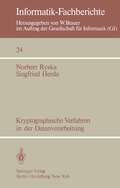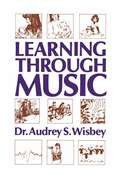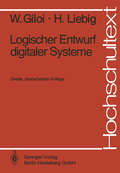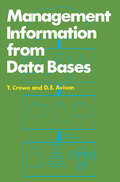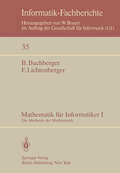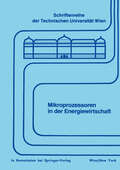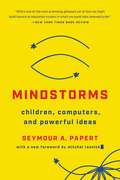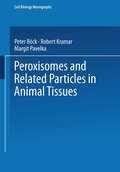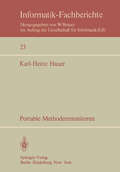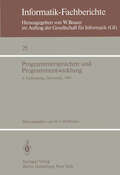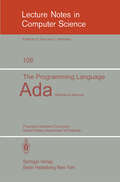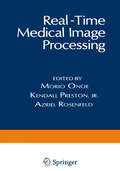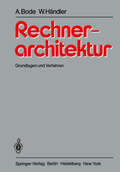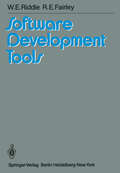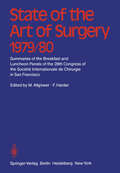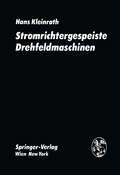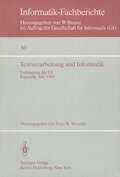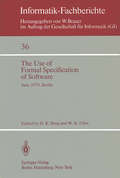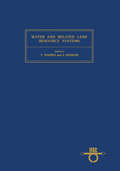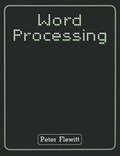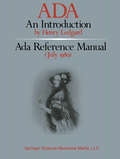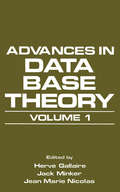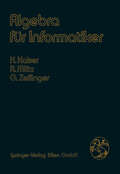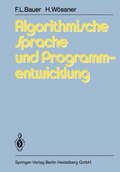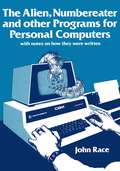- Table View
- List View
Kryptographische Verfahren in der Datenverarbeitung (Informatik-Fachberichte #24)
by Norbert Ryska Siegfried HerdaLogischer Entwurf digitaler Systeme (Hochschultext)
by Wolfgang Giloi Hans LiebigBücher über die Arbeitsweise und den Entwurf logischer oder digitaler Systeme weisen unserer Meinung nach häufig einen Schönheitsfehler auf (manche mehr, manche weniger): sie trennen zu wenig die Betrachtung des funktionellen Ver haltens solcher Systeme von der Betrachtung ihres tee h n i sc he n Verhaltens. Das Standardbuch über Digitaltechnik enthält in der Regel die Definition einer Schalt algebra sowie Methoden der Beschreibung und Minimierung von Schaltnetzen und Schaltwerken, aber zum Beispiel auch die Darlegung der Arbeitsweise von Dioden und Transistoren als logische Verknüpfungselemente, den Aufbau und die Arbeitsweise von Ferritkern-Speichern, und wenn es modern ist, wird es auch die schaltungs mäßige Realisierung von integrierten Verknüpfungselementen behandeln. Wir wollen hierdurch keineswegs ausdrücken, daß die Fragen des technischen Auf baus von logischen Systemen nicht sehr wichtig sind und einer theoretischen Durch dringung wie einer Anleitung zum praktischen Handeln bedürfen. Diese Fragen je doch zum Bestandteil eines Lehrbuchs zu machen, birgt bei dem atemberaubenden Tempo der technischen Entwicklung ständig die Gefahr in sich, daß ihre Darstellung bereits in dem Augenblick veraltet ist, in dem das Buch im Druck erscheint. Die aktuellsten Informationen auf diesem Gebiet sind zwangsläufig die Handbücher der Schal tkrei s -Hersteller.
Mathematik für Informatiker I: Die Methode der Mathematik (Informatik-Fachberichte #35)
by B. Buchberger F. LichtenbergerMikroprozessoren in der Energiewirtschaft (Schriftenreihe der Technischen Universität Wien #13)
by L. BauerMindstorms: Children, Computers, And Powerful Ideas
by Seymour A. PapertIn this revolutionary book, a renowned computer scientist explains the importance of teaching children the basics of computing and how it can prepare them to succeed in the ever-evolving tech world.Computers have completely changed the way we teach children. We have Mindstorms to thank for that. In this book, pioneering computer scientist Seymour Papert uses the invention of LOGO, the first child-friendly programming language, to make the case for the value of teaching children with computers. Papert argues that children are more than capable of mastering computers, and that teaching computational processes like de-bugging in the classroom can change the way we learn everything else. He also shows that schools saturated with technology can actually improve socialization and interaction among students and between students and teachers.Technology changes every day, but the basic ways that computers can help us learn remain. For thousands of teachers and parents who have sought creative ways to help children learn with computers, Mindstorms is their bible.
Peroxisomes and Related Particles in Animal Tissues (Cell Biology Monographs #7)
by P. Böck R. Kramar M. PavelkaIn modern scientific investigation the fields of biochemistry, molecular biology, and morphology comprise an indivisible area of study. The present book results from the cooperation of a bioehernist and morphologists: the revision and unified treatment of available data is the primary object of our work. A comprehensive review of all the available literature is therefore beyond the scope of this volume. lt is intended to be a manual to be used in the laboratory, with convenient guidelines for practical work. Plant microbodies have been treated by B. GERHARDT in Volume 5 of this series. The discovery of fatty acid ß-oxidation in animal peroxisomes has proved once more that plant and animal microbodies are members of the same family of organelles. lt provided new insights into the physiological meaning of these particles; our understanding of these "classical" cell organelies is undergoing continual alteration and development. PETER BöcK Vienna, July 1980 ROBERT KRAMAR MARGIT PAVELKA Acknowledgements We wish to express our gratitude to Prof. Dr. D. H. FAHIMI and Dr. P. KALMBACH (Heidelberg) for kindly providing Figure 14, to Prof. Dr. KARIN GoRGAS (Heidelberg) for allowing the reproduction of Figure 43, to Profs. Dr. L. STOCKINGER and Dr. E. KAISER for helpful criticism, and to all our colleagues in our respective institutes. W e are especially grateful to Drs. H. GoLDENBERG and M. HüTTINGER for continuous discussion, to Mrs. JuTTA SELBMANN for typing the references, and to Mr. P. KAMPFER and Mr. H. WAGNER for carefully drawing some of the figures.
Portable Methodenmonitoren: Dialogsysteme zur Steuerung von Methodenbanken: softwaretechnischer Aufbau und Effizienzanalyse (Informatik-Fachberichte #23)
by K.-H. HauerProgrammiersprachen und Programmentwicklung: 6. Fachtagung des Fachausschusses Programmiersprachen der GI, Darmstadt, 11.–12. März 1980 (Informatik-Fachberichte #25)
by H. J. HoffmannDie Fachtagungen, die der Fachausschuß 2 PROGRAMMIERSPRACH~N der Gesellschaft für Informatik*) seit 1971 regelmäßig, nunmehr zum sechsten Mal, veranstaltet und in Ta gungsbänden dokumentiert, geben Zeugnis von dem jeweiligen Selbst-Verständnis des Faches PROGRAMMIERSPRACHEN, zumindest aus der Sicht einiger seiner Repräsentanten und der Vortragenden. Die 6. Fachtagung, die am 11. und 12. März 1980 in Darmstadt stattfindet, spielt darin sicherlich keine Sonderrolle. Es wurde diesmal eine breitere Thematik gewählt, wie es aus der Tagungsbezeichnung hervorgeht, nämlich PROGRAMMIERSPRACHEN UND PROGRAMMENTWICKLUNG. Jedenfalls wird damit zum Ausdruck gebracht, daß Programmiersprachen nicht nur eine Zielsetzung in sich haben, d.h. einem Selbstzweck unterworfen sind, sondern zu einem weiteren Zweck, der Programmentwicklung, in Beziehung treten, in Beziehung treten müssen. Dieses verbreiterte Selbst-Verständnis hat sich - bedauerlicherweise - im Tagungsprogramm und als Folge davon im Tagungsband nicht übermäßig deutlich ausge wirkt. Die Veranstalter legen allerdings zum Zeitpunkt der Drucklegung die (berech tigte) Hoffnung, daß in der vorgesehenen Diskussion über "Software Engineering - Programmiersprachen, Programmentwicklung -" zu der breiteren Thematik einige beach tenswerte Aussagen kommen. Im Tagungsband, der den Tagungsteilnehmern zu Beginn der Tagung ausgehändigt wird, läßt sich eine solche Diskussion noch nicht einfangen; ihre Auswirkungen zeigen sich, hoffentlich, an anderer Stelle.
The Programming Language Ada: Reference Manual. Proposed Standard Document United States Department of Defense (Lecture Notes in Computer Science #106)
by Honeywell Cii Honeywell BullSoftware Development Tools
by W.E. Riddle R.E. FairleyThis text contains the proceedings of a workshop on software develoDment tools, held at Pingree Park, Colorado in May, 1979. The workshop, for which we were co-chair men, was primarily, but not exclusively, concerned with a variety of tools supporting pre-implementation phases of software development. The workshop brought together researchers and practitioners from industrial, governmental, and academic sectors to compare and assess current work and to set some directions for future work in this emerging technical area. The fifty participants represented research and development efforts in software tools within the United States, Canada, France, Great Britain, and Japan. (A list of participants appears at the end of the text. ) Sponsorship was provided by the National Aeronautics and Space Administration, the National Bureau of Standards, the National Science Foundation, and Digital Equipment Corporation. The conference consisted of seven formal sessions and numerous organized and impromptu discussions. Each session (except the last) included invited papers, prepared remarks by discussants, and an open discussion.
State of the Art of Surgery 1979/80: Summaries of the Breakfast and Luncheon Panels of the 28th Congress of the Société Internationale de Chiurgie in San Francisco
by Martin Allgöwer and Felix HarderInternational surgical meetings with thousands of participants speaking a dozen different languages tend to be frustrating for the individual who comes with the hope of learning about progress in his fields, but who additionally would like to be able to ex change ideas on controversial topics and to meet competent people with whom to discuss specific problems. In the "one-way" ses sions in which long papers are presented, details or specific points may be missed. Differing views often are not adequately discussed, because the meeting and its participants are pressed for time. The 44 breakfast and luncheon sessions, covering different topics of interest to the practicing surgeon, were mainly planned to overcome these classical "congress handicaps" and also to do away with the anonymous atmosphere of such a large congress. Slides and formal papers were banished from these sessions. The outcome of these very lively and pleasant discussions taking place around small well-dressed tables was unexpected by most participants. A chairman and several panel members shared their repast, caloric and intellectual, with some 10-30 congress par ticipants. The result was in each instance a lively, informative intimate discussion, very different from the anonymous atmo sphere of a large meeting. In the hope of preserving these ex changes, the chairmen were requested immediately the session finished to "distill the essence" of the 90-minute exchange into a summary captured on tape.
Textverarbeitung und Informatik: Fachtagung der GI Bayreuth, 28. – 30. Mai 1980 (Informatik-Fachberichte #30)
by P. R. WossidloThe Use of Formal Specification of Software: June 25–27, 1979, Berlin (Informatik-Fachberichte #36)
by H. K. Berg W. K. GiloiThe notion that program design is an engineering task alleviating the software crisis has been with us for about a decade. With the recognized advantages of obeying to certain software design disciplines, we are approaching the era of enforced system development standards which will ensure that end products will meet rigorous design requirements. On the one hand, advances in system architecture fUrther the application of system development standards to software and firmware design and production. On the other hand, the growth in complexity of future system architectures, in particular distri buted systems with their special problems of cooperation and parallelism, necessitate the use of rigorous specification and design techniques. In addition to hampering the design process, the lack of engineering techniques hinders research. In many cases, trial designs that are presented in abstract and informal terms do not force the de signer to face the full problem spectrum, and therefore may not sufficiently provide insight into the design process. To prepare for the forthcoming discipline and to provide a snapshot view of recent advances in software and firmware engineering, we organized in June of 1979 a seminar entitled: "The Use of Formal Specification of Software and Firmware". The seminar took place at the Heinrich-Hertz-Institute, Berlin, and attracted over 60 participants, most of them from the industry.
Water and Related Land Resource Systems: IFAC Symposium, Cleveland, Ohio, U.S.A., 28-31 May 1980
by Y. Haimes J. KindlerWater and Related Land Resource Systems covers IFAC Symposium that aims to address resource problem, as well as methodologies and procedures for respective solutions. Consists of 60 chapters, the book is organized in sessions according to the technical program of the conference. The book first tackles multiobjective planning in water and land resources, which is followed by acquisition and analysis of surface water quality data. The next part covers hierarchical water resource planning and management models, while the succeeding part is about environmental and ecological aspects of water and land resources. The fifth session discusses the impact of energy development on water and land resources. Session VI covers modeling and systems identification problems in water resources, and Session VII covers acquisition and analysis of hydrologic data. The eighth session tackles ground water and its conjunctive use with surface water, while the next session talks about sedimentation and land management. The tenth session is about multiobjective planning in water and land resources. Predicting and forecasting models in water resources is the topic of Session XI, while Session XII discusses evaluation and calibration problem in water resource modeling. The closing chapter covers water and land issues in urban areas. Professionals whose work revolves around recourse management and researchers whose work is in line with natural resource will find great information in this book that will be relevant in their trade.
ADA An Introduction: Ada Reference Manual (July 1980)
by H. LedgardIf Charles Babbage is to be regarded as the father of modern day computer technology, then surely the Countess Augusta Ada Lovelace, after whom this new language is named, must be remembered as its midwife. It was she, the daughter of England's poet Lord Byron, who translated the work of the Italian mathematician L.F. Menabrea, attaching her own scientific commentaries on the dissimilarities between the difference engine and .the analytical engine. It was Lady Lovelace, the great lady of computers, who delivered the notes and loosely organized writings of Babbage, with her own invaluable amendments, to a world not quite ready to receive them. The Ada language effort has employed hundreds, if not thousands, of minds and a healthy sum of money since its conception. Ada was fostered by the High Order Language Working Group (HOLWG), chartered by the U.S. Department of Defense in January of 1975 with the overall objective of developing a systematic approach to improved use of software by the military. One would think the Pentagon an unlikely foster parent for a new computer language. Regardless of its lineage, the question that begs asking is, of course-Why? The answer is by no means a simple one, but some brief background may help to clarify the matter. At present, the Department of Defense is the largest software consumer on earth, employing roughly 400 different computer languages and dialects. The situation, some have commented, is at best untidy.
Algebra für Informatiker
by Hans Kaiser Rainer Mlitz Gisela ZeilingerDas Kernstück des vorliegenden Buches entstand aus einer einsemestrigen Vor lesung gleichen Namens, die die Autoren seit mehreren Studienjahren an der Technischen Universität Wien betreuen und die von R.Mlitz ausgearbeitet wurde. Es erschien den Autoren notwendig bzw. zweckmäßig dieses Kernstück zu ergänzen durch lineare Algebra - die an der TU Wien getrennt vorgetragen wird - und graphentheoretische Grundbegriffe. Die von den Autoren gewonnenen Erfahrungen haben die vom üblichen Schema abweichenden didaktischen Aspekte der Darstellung geprägt, deren Grundprinzip in der nachfolgenden Einleitung erläutert wird. Das Buch richtet sich zunächst an Studierende der Informatik zum Gebrauch neben entsprechenden Vorlesungen, zum Nachschlagen und Wiederholen. Darüber hinaus soll der Anwender angesprochen werden, der in dem Werk die wichtigsten algebraischen Methoden des Informatikers dargeboten findet. Die Darstellung beschränkt sich auf den mathematischen Hintergrund und dessen direkte Anwendung. Bezüglich eventueller technischer Realis;erungen sei auf die entsprechende Literatur verwiesen. Unser besonderer Dank gilt Frau E.Wiesenbauer und Frau H.Reinauer für die sorgfältig durchgeführten Schreibarbeiten, Herrn Mag.W.Nowak für die genaue Ausführung der Graphiken, sowie dem Springer-Verlag Wien für sein Entgegenkommen und die gute Zusammenarbeit.
